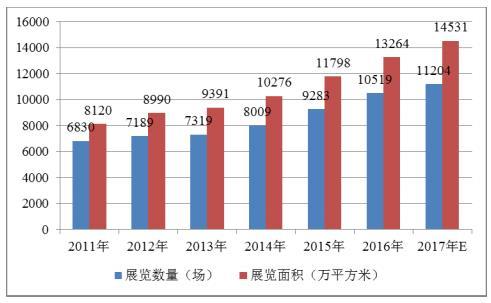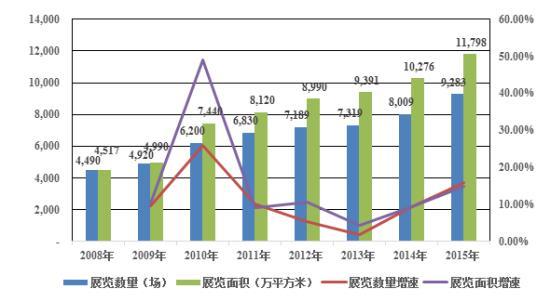I. exhibition industry has become an important platform for building a modern market system and an open economic system
In recent years, the rapid development of China's exhibition industry has become an important platform to build a modern market system and an open economic system, playing an increasingly prominent role in China's economic and social development. In 2015, the state council issued several opinions on further promoting the reform and development of the exhibition industry (guo fa [2015] no. 15), which was the first time that the state council comprehensively and systematically proposed the strategic goals and main tasks of the development of the exhibition industry.
The development of the exhibition industry has a strong role in promoting the economic and social development of the industry and the region. The exhibition industry can not only effectively promote consumption and expand domestic demand, but also contribute to the improvement of urban service level and infrastructure construction level, and improve the management level, civilization level, popularity and reputation of a city. At the same time, the exhibition industry contributes to the upgrading of technology and structure of the real industry. The exhibition has become an important platform to showcase the diplomacy of major countries. With the continuous improvement of the level of economic globalization, the exhibition industry is playing an increasingly important role in promoting trade exchanges, technological exchanges, information communication, economic cooperation and increasing employment.
Chinese President xi jinping stresses at the opening ceremony of the boao Asia BBS annual conference 2018 on April 10, 2018: "we will hold the first China international import expo in Shanghai this November. This is not a general exhibition, but a major policy announcement and action of our initiative to open up the market." As a leading enterprise in China's exhibition industry, zhenwei exhibition was entrusted by the ministry of commerce to be responsible for the exhibition coordination and service related work of the emerging technology section of China international import expo service trade exhibition area.
Ii. Exhibition industry has become an important pillar industry in first-tier cities in China
Exhibition industry as an important platform for investment and trade, not only can effectively promote the growth of industry and consumption, but also as an important part of modern high-end service industry, host city accommodation and catering, transportation and logistics, advertising and communication, tourism shopping and other industries have an obvious driving effect. At present, more and more cities begin to attach importance to the development of exhibition industry, which has injected more growth power into the stable development of exhibition industry. Exhibition industry plays a leading role in promoting supply-side structural reform. Exhibition for producers and consumers to create a platform, has a strong role in leading and driving production, social and economic development into new vitality, so as to bring new opportunities for the sustained growth of exhibition industry. First-tier cities in China, such as Beijing, Shanghai, guangzhou and shenzhen, have issued documents to promote the reform and development of the exhibition industry. The exhibition industry has become an important pillar industry in first-tier cities in China.
Iii. The scale of China's exhibition industry continues to grow, and the output value of exhibition economy continues to expand
From 2011 to 2016, the number of exhibitions in China rose from 6,830 to 10,519. Exhibition space rose to 132.64 million square meters from 81.2 million square meters. The exhibition area grows faster than the exhibition project, the unit project scale expands, and the exhibition industry benefit is good.

Iv. The exhibition industry is beginning to take shape, transforming from quantitative expansion to qualitative improvement
After more than ten years of rapid development, China's exhibition industry has begun to take shape. According to the development report of China's exhibition industry (2016) released by China association of exhibition economy, a total of 9,283 exhibitions were held nationwide in 2015, covering an exhibition area of 11,798 million square meters. The direct output value of the exhibition economy reached 480.31 billion yuan, accounting for 0.71% of the national GDP and 1.41% of the added value of the tertiary industry. From 2008 to 2015, the number of domestic exhibition venues and exhibition area have achieved steady growth
According to the above statistics, in addition to the overall growth trend of domestic exhibitions, the growth rate of exhibition area is faster than that of exhibition quantity, the exhibition scale of individual exhibitions expands, and the effect of scale economy is obviously strengthened. The development mode of exhibition industry has made a qualitative leap from quantitative expansion to qualitative improvement. In 2015, there were 124 exhibition projects covering more than 100,000 square meters nationwide, 16 more than in 2014, among which the exhibition area of the largest exhibition reached 1.18 million square meters. Take Shanghai, where the exhibition industry is relatively developed, for example, compared with 2014, the number of exhibitions in Shanghai in 2015 decreased by 20, but the exhibition area increased by nearly 2,325,500 square meters. In 2015, the overall average of single exhibition in Shanghai was more than 20,000 square meters, showing obvious economies of scale.

5. Exhibition units tend to be marketized and the industry concentration ratio is relatively low
From the nature of exhibition organizing units, domestic organizing units can be divided into four types: party and government organs, trade associations, foreign-funded enterprises and domestic enterprises. According to the statistics of ccpit, there were 1,406 domestic enterprises holding exhibitions in the exhibition industry in 2016, 80 more than in 2015, accounting for 57.13%. There were 863 trade associations, 424 more than 2015, accounting for 35.07%. There were 151 party and government organs, 9 more than in 2015, accounting for 6.14% of the total. There were 41 foreign-funded enterprises, 37 fewer than in 2015, accounting for 1.67 percent. The number of domestic enterprises and industry associations organizing exhibition units is increasing, while the number of party and government organs and foreign-funded enterprises organizing exhibition units is growing less or decreasing. The concentration of domestic exhibition market is relatively low, most exhibition companies are relatively weak in scale and strength, and the number and exhibition area of the exhibition held are limited. According to the statistics of ccpit, nearly 70% of the exhibition area in 2016 was between 10,000 and 50,000 square meters, of which 10,000 to 30,000 square meters of small-scale exhibition occupied the mainstream. There are 1310 exhibitions covering an area of 1-3 thousand square meters, accounting for 52% of the total number of known exhibitions. There are 482 exhibitions covering an area of 30,000-50,000 square meters, accounting for 19% of the total number of known exhibitions.




